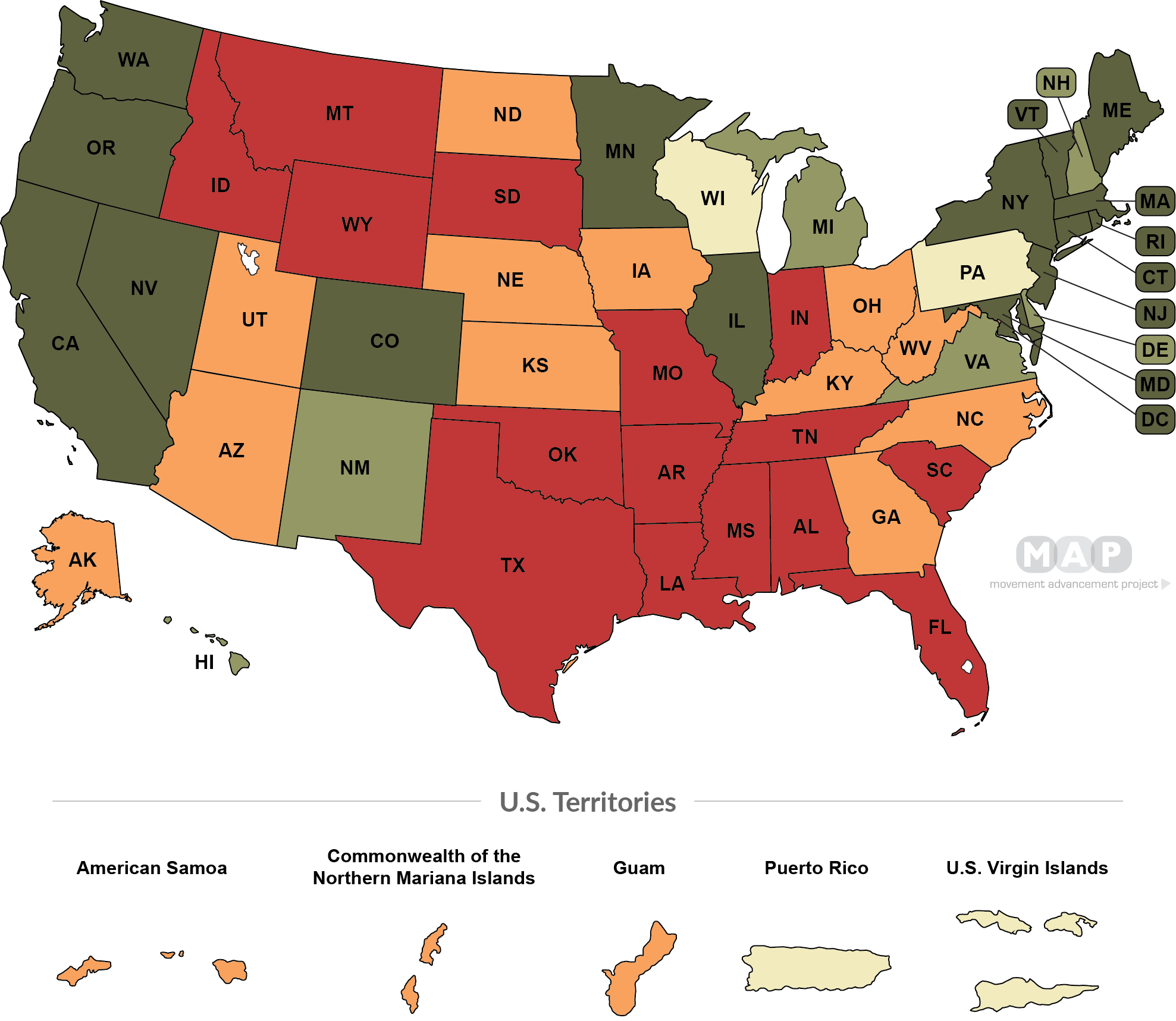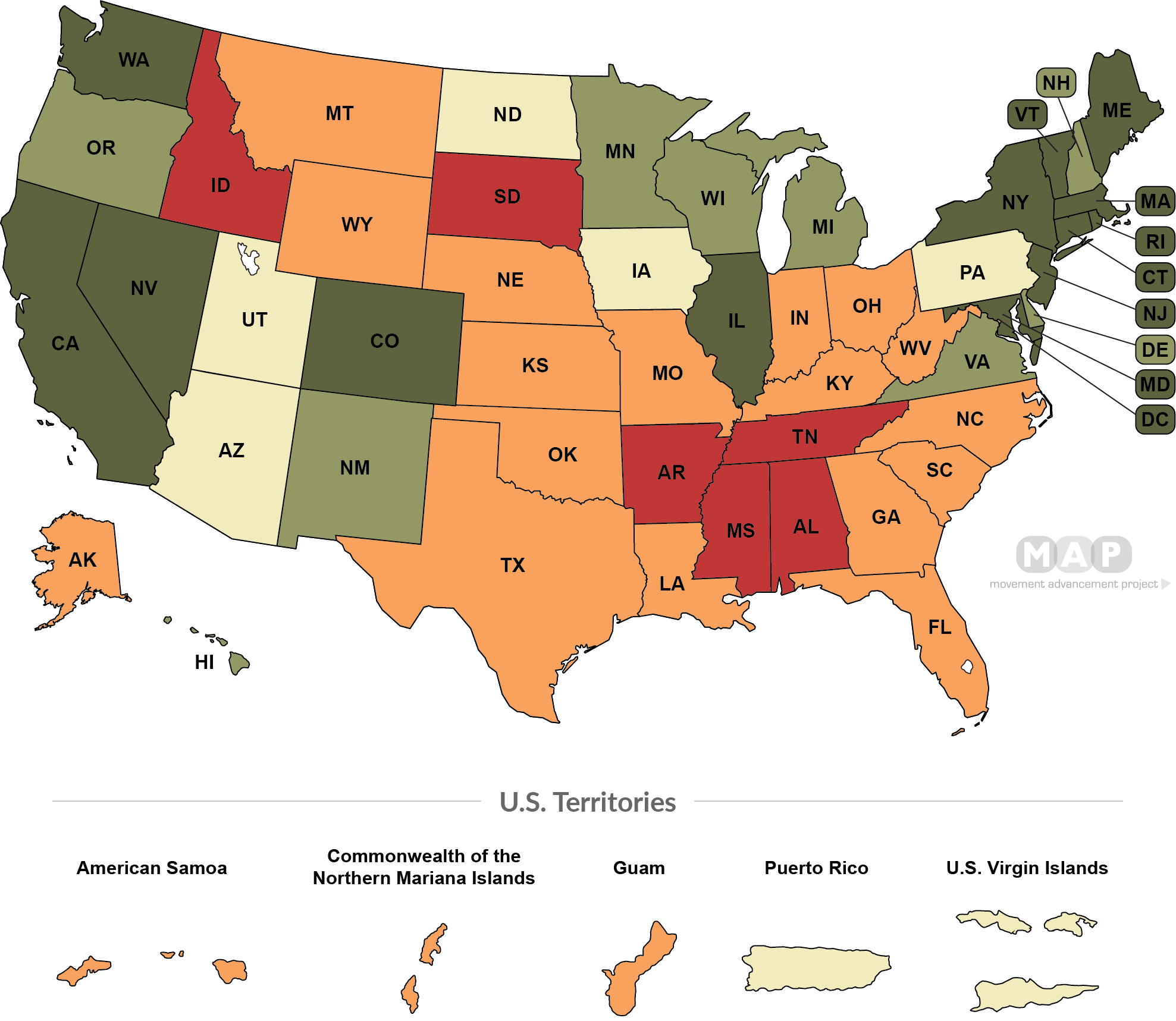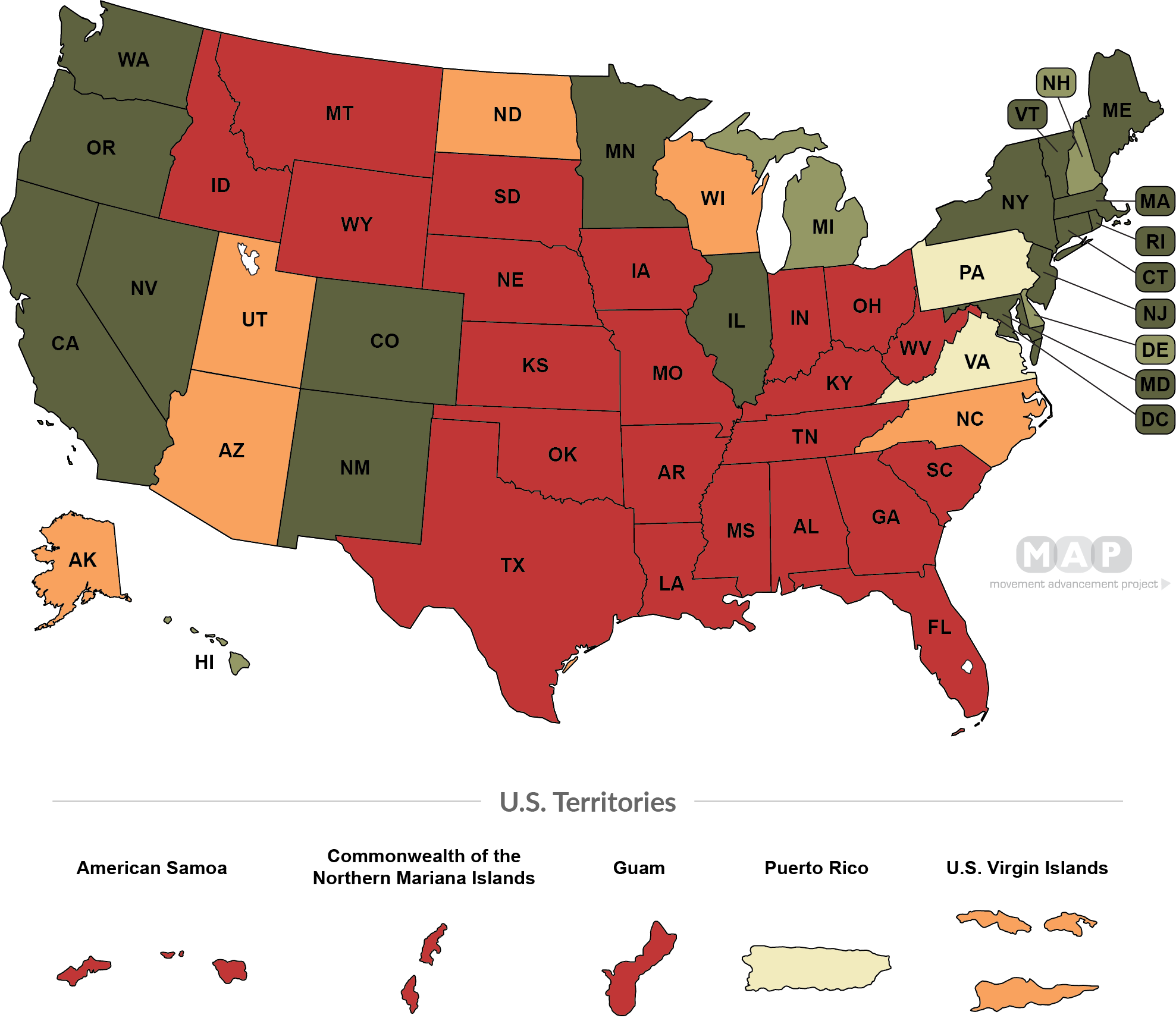
The Movement Advancement Project (MAP) tracks over 50 different LGBTQ-related laws and policies. This map shows the overall policy tallies (as distinct from sexual orientation or gender identity tallies) for each state, the District of Columbia, and the five populated U.S. territories. A state’s policy tally scores the laws and policies within each state that shape LGBTQ people's lives, experiences, and equality. The major categories of laws covered by the policy tally include: Relationship & Parental Recognition, Nondiscrimination, Religious Exemptions, LGBTQ Youth, Health Care, Criminal Justice, and Identity Documents.
Click on any state to view its detailed policy tally and state profile, or click "Choose an Issue" above to view maps on over 50 different LGBTQ-related laws and policies.

Note that these scores reflect only existing laws and policies. They do not reflect bills currently under consideration, nor the implementation of each state’s laws. The tally also does not reflect the social climate in a state, the efforts of advocates, and/or opportunities for future change. States with lower scores might shift rapidly with an influx of resources, and states with higher scores might backslide, or they might expand equality for LGBTQ people in ways that can provide models for other states. In other words, these scores are an excellent measure of the current LGBTQ policy landscape across a wide range of issues, but the scores do not necessarily reflect the entire political or social landscape for LGBTQ people.
Each of the over 50 LGBTQ-related laws and policies that MAP tracks earns a score (positive for protective, or negative for harmful). See a state's profile to see its detailed scores across all these policies. For each state, these individual policy scores are then added up to produce a summary tally score. This table shows how a state's tally score determines its categorization.
Below are the current scoring thresholds. Each category reflects a percentage range of the total possible points. For example, earning 25-49.9% of the total points possible results in a "Fair" categorization.
Recommended citation:
Movement Advancement Project. "Equality Maps Snapshot: LGBTQ Equality By State." https://www.mapresearch.org/equality-maps/ . Accessed 09/09/2024.
*Note: These percentages reflect estimates of the LGBTQ adult population living in the 50 states and the District of Columbia. Estimates of the LGBTQ adult population in the five inhabited U.S. territories are not available, and so cannot be reflected here.
40 % of the LGBTQ population lives in states with high overall policy tallies
8 % of the LGBTQ population lives in states with medium overall policy tallies
7 % of LGBTQ population lives in states with fair overall policy tallies
16 % of LGBTQ population lives in states with low overall policy tallies
29 % of LGBTQ population lives in states with negative overall policy tallies
The Movement Advancement Project (MAP) tracks over 50 different LGBTQ-related laws and policies. This map shows the sexual orientation policy tallies for each state, the District of Columbia, and the five populated U.S. territories. A state’s policy tally scores the laws and policies within each state that shape LGBTQ people's lives, experiences, and equality. The major categories of laws covered by the policy tally include: Relationship & Parental Recognition, Nondiscrimination, Religious Exemptions, LGBTQ Youth, Health Care, Criminal Justice, and Identity Documents.
Click on any state to view its detailed policy tally and state profile, or click "Choose an Issue" above to view maps on over 50 different LGBTQ-related laws and policies.

NOTE: This tally includes laws that explicitly mention sexual orientation. The term “sexual orientation” is loosely defined as a person’s pattern of emotional, romantic, or sexual attraction (or lack thereof) to people. Laws that explicitly mention sexual orientation primarily target, whether for protection or harm, lesbian, gay, and bisexual people. Transgender people can also be affected by laws that explicitly mention sexual orientation.
total points possibleRecommended citation:
Movement Advancement Project. "Equality Maps: Snapshot: LGBTQ Equality By State." https://www.mapresearch.org/equality-maps/. Accessed 09/09/2024.
*Note: These percentages reflect estimates of the LGBTQ adult population living in the 50 states and the District of Columbia. Estimates of the LGBTQ adult population in the five inhabited U.S. territories are not available, and so cannot be reflected here.
38 % of the LGBTQ population lives in states with high sexual orientation policy tallies
12 % of the LGBTQ population lives in states with medium sexual orientation policy tallies
12 % of LGBTQ population lives in states with fair sexual orientation policy tallies
32 % of LGBTQ population lives in states with low sexual orientation policy tallies
5 % of LGBTQ population lives in states with negative sexual orientation policy tallies
The Movement Advancement Project (MAP) tracks over 50 different LGBTQ-related laws and policies. This map shows the gender identity policy tallies for each state, the District of Columbia, and the five populated U.S. territories. A state’s policy tally scores the laws and policies within each state that shape LGBTQ people's lives, experiences, and equality. The major categories of laws covered by the policy tally include: Relationship & Parental Recognition, Nondiscrimination, Religious Exemptions, LGBTQ Youth, Health Care, Criminal Justice, and Identity Documents.
Click on any state to view its detailed policy tally and state profile, or click "Choose an Issue" above to view maps on over 50 different LGBTQ-related laws and policies.

NOTE: This tally includes laws that explicitly address or impact gender identity and/or expression. “Gender identity” is a person’s deeply-felt inner sense of being male, female, or another gender(s). “Gender expression” refers to a person’s characteristics and behaviors such as appearance, dress, mannerisms, and speech patterns, all of which can be described as masculine, feminine, or something else. Gender identity and expression are independent of sexual orientation. Transgender people may identify as heterosexual, lesbian, gay, bisexual, queer, or something else. Laws that explicitly mention “gender identity” or “gender identity and expression” primarily target, whether for protection or harm, transgender people. These laws also can apply to people who are not transgender, but whose sense of self or expression does not adhere to gender stereotypes.
total points possibleRecommended citation:
Movement Advancement Project. "Equality Maps: Snapshot: LGBTQ Equality By State." https://www.mapresearch.org/equality-maps/ . Accessed 09/09/2024.
*Note: These percentages reflect estimates of the LGBTQ adult population living in the 50 states and the District of Columbia. Estimates of the LGBTQ adult population in the five inhabited U.S. territories are not available, and so cannot be reflected here.
41 % of the LGBTQ population lives in states with high gender identity policy tallies
8 % of the LGBTQ population lives in states with medium gender identity policy tallies
4 % of LGBTQ population lives in states with fair gender identity policy tallies
10 % of LGBTQ population lives in states with low gender identity policy tallies
37 % of LGBTQ population lives in states with negative gender identity policy tallies